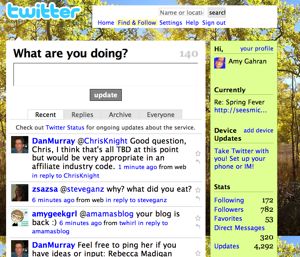Introduction
By Amy Gahran, I, Reporter

Twitter has fast become one of the most popular and useful social media services.
When a major earthquake struck Sichuan province, China, on May 12, 2008, the very firstreports came from cell-phone-powered eyewitnesses in the affected region. Before the ground even completely stopped shaking, people were firing off text messages announcing the quake. Some of those messages went to a popular social media service that integrates easily with both cell phones and computers: Twitter.
Once word of the Chinese quake hit Twitter, the world took notice. In fact, according to a detailed analysis by Search Engine Land, the news broke on Twitter a full three minutes before even the US Geological Survey’s Earthquake Center announced the quake.
From those first moments, Twitter users around the world were instantly sharing quake-related news, resources, and personal accounts. In fact, for several hours famed blogger Robert Scoble became a one-man China quake info clearinghouse, funneling information to his more than 25,000 Twitter followers.
Similarly (but on a smaller scale), on May 22, 2008, a large tornado struck Windsor, Colo., just 50 miles from my home in Boulder. I was first alerted to my local severe weather via Twitter – by a friend who lives in California! I then used a combination of Twitter and mainstream news sites to track events. I instantly shared what I was learning as I learned it via Twitter, sending updates to more than 700 of my friends, colleagues, and other interested people – many of whom I don’t even know, but they’ve chosen to get updates from me.
From a citizen media perspective, that’s pretty powerful. Not only can anyone’s news matter — it can matter fast!
As a “microblog,” Twitter is built for speed. Posts are capped at 140 characters and can be updated via the Web or cell phone text messages, meaning even if you happen upon breaking news and don’t have your laptop handy, you can still break the story.
Over the last several months Twitter has finally hit its stride as a leading tool for finding and sharing timely information from all sorts of places and sources. Its usefulness for breaking news is obvious. However, Twitter is equally useful for tracking ongoing stories and issues, getting fast answers or feedback, finding sources, building community, collaborating on coverage, and discovering emerging issues or trends.
All this from a free service that only lets you post text messages up to 140 characters long. Well, it’s amazing what you can say and do in just 140 characters.
In this learning module I’ll explain why citizen journalists should use Twitter and how to get started with Twitter. I’ll also show how using Twitter on a daily basis can improve your citizen journalism. I’ll recommend some handy Twitter tools, and I’ll warn you about some Twitter pitfalls and shortcomings.
